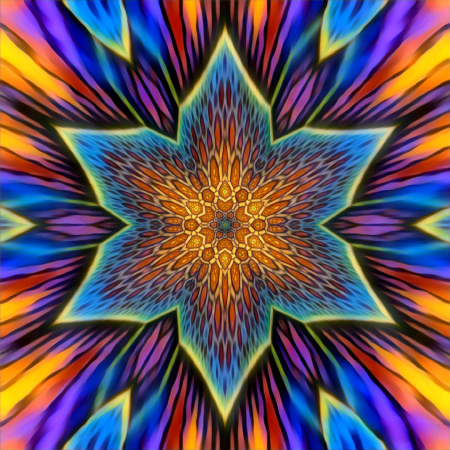Classical Tantra & Neo-Tantra
Most westerners who hear the word “Tantra” think of sacred sexual practices aimed at creating bliss through cultivation of sexual energy and pleasure. The original Tantra, however, is a form of spiritual practice and philosophy that originated in India about 1500 years ago and influenced all of the religions of India at that time. Tantric spiritual paths shared the perspective of embracing the world rather than rejecting it; in addition, they all included distinctive elements such as guru, initiation, mantra, yantra, and complex ritual forms. The paths that have survived to this day are known collectively as “classical Tantra” – the most well-known include Nondual Shaiva Tantra (or Kashmir Shaivism) and Vajrayana or Tantric Buddhism.
The View of classical nondual Tantra involves waking up to the realization that oneself, one’s own bodymind, is not different from the vast awareness that constitutes the bodymind of the entire Universe. This divine essence has chosen, of its own free will, to create all the forms and beings of the universe out of itself – including you! Each encounter, each action, each choice is God encountering God, God acting on God, God choosing God. In order to support the recognition of God/self in all things, along with appreciating and “feeding” our senses with beauty and pleasure, classical Tantra has involved transgressive or shocking practices such as eating seemingly disgusting bodily substances, meditating in the ashes of funeral pyres or on corpses, or engaging in forbidden and potentially distasteful sexual acts. Today’s classical Tantrikas occasionally engage in transgressive practices, but most of the path involves practices such as meditation, asana, breathwork, ritual, mantra recitation, and dissolving harmful mental constructs. The goal of classical Tantra is stabilized awakening – abiding in blissful awareness of the nondual identity of self and universe.
In the mid to late 1800’s, translations of Tantric scriptures began to filter into the Western world. The quality of these translations was not up to modern standards, but even so, the ideas sparked the interest of spiritual explorers and occult societies. Through these lecturers and teachers, and through Indian teachers such as Osho, sacred sexual practices loosely based on Tantric concepts spread and gained popularity. Though most practitioners simply refer to these teachings as “Tantra”, it is more accurate and respectful to give them the name “Neo-Tantra” to distinguish them from the original and surviving classical teachings. Here is a beautiful expression of the Neo-Tantric path from an influential teacher:
“Tantra is a spiritual path to enlightenment, but unlike most mystical paths, Tantra includes sexuality as a doorway to ecstasy and enlightenment.… Tantra challenges the belief promoted by most spiritual and religious paths that we must suppress or transcend our sexuality to practice meditation or awaken our Spirit. Tantra arose in rebellion against these ascetical and life-negating creeds. It acknowledges that sex is at the root of life and that to make human sexuality and erotic union a form of worship and meditation is to practice reverence for life, leading us directly through the pleasure of the senses to spiritual liberation. Tantra teaches that we master desires not by avoiding them but by immersing ourselves in them … We need not suffer by sacrificing pleasures. We can cultivate them as opportunities for awakening.”
~ Margot Anand, The Art of Everyday Ecstasy
Many practitioners of Classical Tantra find it emotionally painful and publicly damaging when their spiritual path of awakening is equated in the public mind with instruction on how to have better orgasms and healthier relationships. We offer this short essay in order to support our readers in distinguishing between Classical Tantra and Neo-Tantra and referring to teachers, schools, and practices with respectful clarity.
This brief history of Classical Tantra and Neo-Tantra is gratefully summarized by Sarah Taub from the work of Tantrik scholar and teacher Christopher Wallis. For more information:
Here is a beautiful lyrical essay from Matthias Rose on the shared heart of Classical Tantra and Neo-Tantra:
For more information on Classical Tantra, visit our resource list here.
